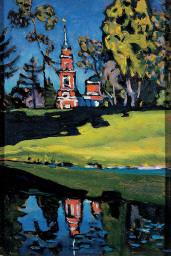This lakeside town is offering visitors the rare chance to enjoy a selection of masterpieces by four stars of Russia's early 20th-century avant-garde movement.
The exhibition, opening on Saturday, features over 80 works of art by Wassily Kandinsky, Marc Chagall, Kazimir Malevich and Pavel Filonov.
On show will be a mix of oil paintings, tempera works and drawings on loan from leading Russian museums and private collections, which trace the movement's development from the early 1900s through to the 1930s.
Discussing the development of the movement, Como Culture Councillor Sergio Gaddi, who helped curate the exhibition, underscored the importance of setting it within its historical and geographical context.
''Although using different artistic techniques, Chagall, Kandinsky and Malevich distanced the language of art from the logic of tradition and the bourgeoisie,'' he explained.
''In so doing, they went beyond the prevailing vision of French Impressionism to give life to the formal innovations of Cubo-Futurism, the tensions of Suprematism and the rarefied modernity of Abstraction''.
Gaddi pointed to the ''extraordinary substance of Russian avant-garde movements spanning the early decades of the 20th century, until the realist turning point imposed by Stalin after 1934''.
The exhibition is divided into four sections, each of which looks at the work of a different artist.
The starting point is Kandinksy (1866-1944), who injected a new element into figurative art in 1910 with his 'Abstract Watercolour'.
The show features a handful of pieces from the immediate period after that, including his 1912 essay entitled ''The Spirituality of Art''. However, a selection of his abstract paintings created between 1915 and 1919 will be of particular interest, such as 'Two Ovals' and 'Overture', both from 1919, and two oil paintings on glass from 1918.
There are over 20 pieces on display by Malevich (1878-1930). These map out the sharp shifts in his career, starting with his early fascination with European painting. From this era are pieces such as 'High Society In Top Hats Relaxing'(1908) and a 1910 self-portrait.
Cubo-Futurist influences started appearing in his work not long after, followed by a Suprematist phase, which culminated in 'Red Square' in 1915.
His later work, produced in the aftermath of Russia's 1917 Communist Revolution, adopted a neo-figurative approach. This period is represented by works such as 'Head of a Peasant' (1928-9), which has been selected as the exhibit's poster image.
The Chagall (1887-1985) section includes a fascinating reconstruction of his studio, complete with furniture, but there are also a number of his masterpieces on show.
These include 'Self-portrait With A Palette' (1914), 'The Red Jew' (1915) and 'The Mirror' (1915).
The final part of the show looks at the work of Filonov (1883-1914) whose work fell into semi-obscurity after it was banned in the 1960s but which has seen a massive revival in recent years.
His works combine elements of mysticism and spirituality, at times verging on the apocalyptic, beautifully encapsulated in one of his most famous works, on loan from the Russian Museum, 'Peasant Family (The Holy Family)' (1914).
'Chagall, Kandinsky, Malevich. Masters of the Russian Avant-Garde' is on show at the Villa Olmo in Como until July 26.




